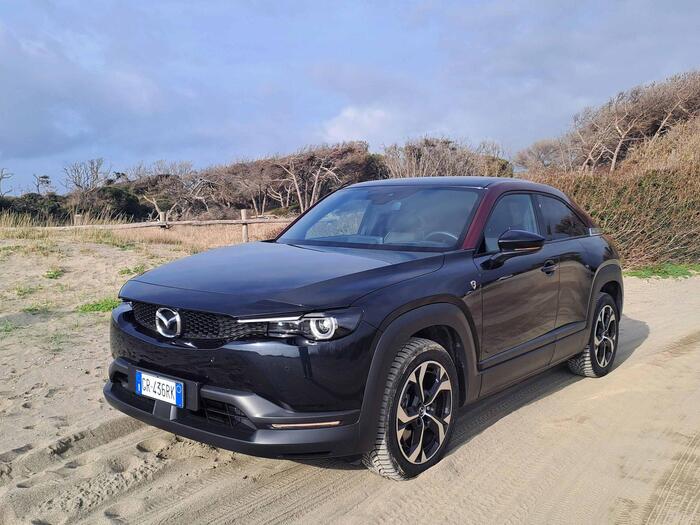Born as a purely electric car, the Mazda MX-30 evolves and, thanks to a thermal generator, frees itself from dependence on the plug and becomes the MX-30 R-EV.
A plug-in hybrid car, with an e-Skyactiv engine - the acronym that identifies the brand's electric engines - combined with a rotary engine that gives it the R-EV suffix.
The Japanese company therefore continues on its path to reduce emissions, but with its own style.
The Mazda MX-30, in fact, was designed as a pure electric car, and only later evolved into an electrified one.
ANSA Motori, which followed the genesis of the project from the beginning, tested this car for a long time, on urban routes and on extra-urban journeys, verifying the 'double nature': being able to count on an autonomy of around 75 km (85 km declared ) - quite a lot for a plug-in - with just the battery with a capacity of 17.8 kWh, on daily city journeys it behaves like a pure electric vehicle while on longer journeys it is free from the constraints of charging thanks to the ability to generate energy through the rotary engine, but always with an eye on emissions: the maximum speed, even with this engine, is 140 km/h as in the MX-30 BEV.
During the test we used a 6 kW home wallbox for charging, more than enough to fill up on energy during hours of non-use.
The savings are notable: around 2.5 euros of electricity (the cost of less than 1.5 liters of fuel) for a full tank.
The rotary engine, a return for Mazda which had used it on series models until 2012 and subsequently continued to develop, was chosen as a generator due to its high efficiency in the face of small dimensions (830 cc) which allowed to position it in the engine compartment without reducing the space in the passenger compartment.
Photo story Mazda MX-30 R-EV Edition R
.
The electric unit - the only one connected to the traction - delivers 170 HP with a torque of 260 Nm;
75 HP for the thermal one: exclusively with generator function, it can count on a 50 liter fuel tank.
If even more marked acceleration is necessary, by pushing the pedal all the way down the generator delivers an energy boost.
As is in Mazda's DNA, the car - and in this it does not differ from its pure electric 'sister' - is built around the driver, with great attention - especially in the Edition R version tested - to materials, comfort and safety , the pleasure of driving and the eco-friendly philosophy that animated the entire project.
The MX-30 has three driving modes: Normal, which favors electric movement and starts charging the battery when necessary;
EV, totally electric;
Recharge, increases battery charge thanks to the thermal engine.
The choice of driving mode does not affect the car's top speed of 140 km/h.
The accelerator pedal has a double calibration which allows, if pressed fully, to combine the combustion engine with the electric one.
The choice of the capacity of the battery chosen is important from the beginning, taking into account that the accumulators are, to date, the component that most influences the final cost of the car.
In fact, on-board reactivity does not reveal any particularly significant differences between the MX-30 BEV and PHEV.
This is also thanks to the e-GVC Plus (Electronic G-Vectoring Control Plus) technology which offers fluidity of movement to the vehicle, giving excellent maneuverability in all circumstances.
Home charging has already been said.
Using a 36 kW rapid charging station, you can go from 20% to approximately 80% charging, which becomes 50 when using an 11 kW system and 90 when using a 7.2 kW charger. .
The car tested, a Mazda MX-30 e-Skyactiv R-EV in the special "Edition R" trim, is identified not only by the rotor-shaped emblem on the front wheel arches of all R-EVs, but also by the Maroon color Rouge Metallic which pays homage to the color of the roof of the Mazda R360 Coupé, the brand's first car, around the sides of the roof and while black is the base color for the bodywork, roof and interior trim.
The R logo on the upholstery and interior.
The price list starts at 38,500 euros, around 46 thousand for the Edition R, truly full optional.
Reproduction reserved © Copyright ANSA

